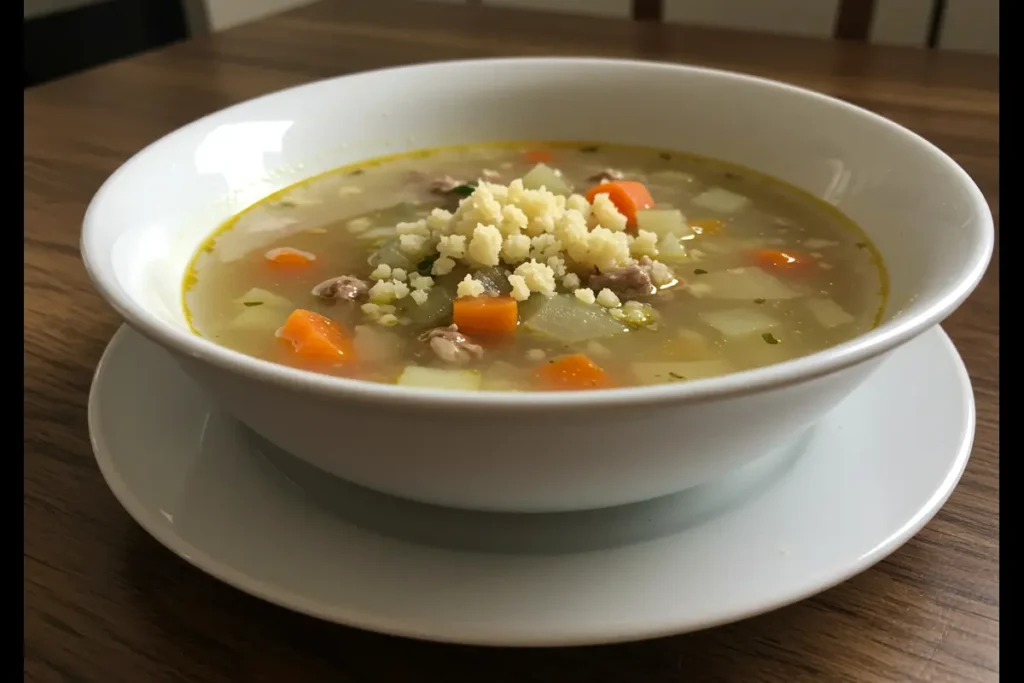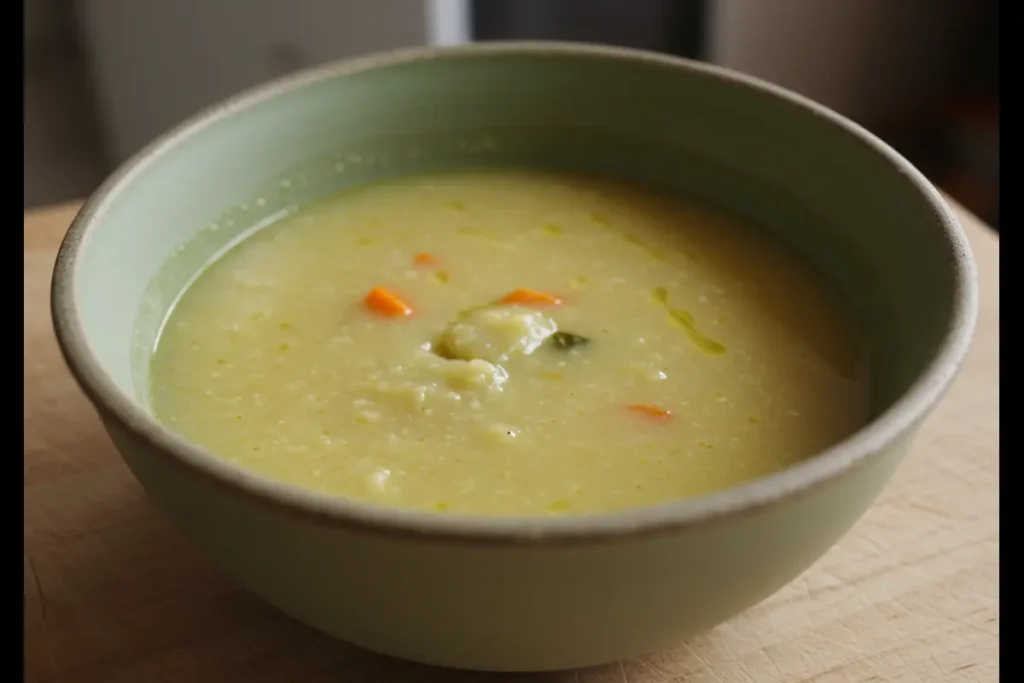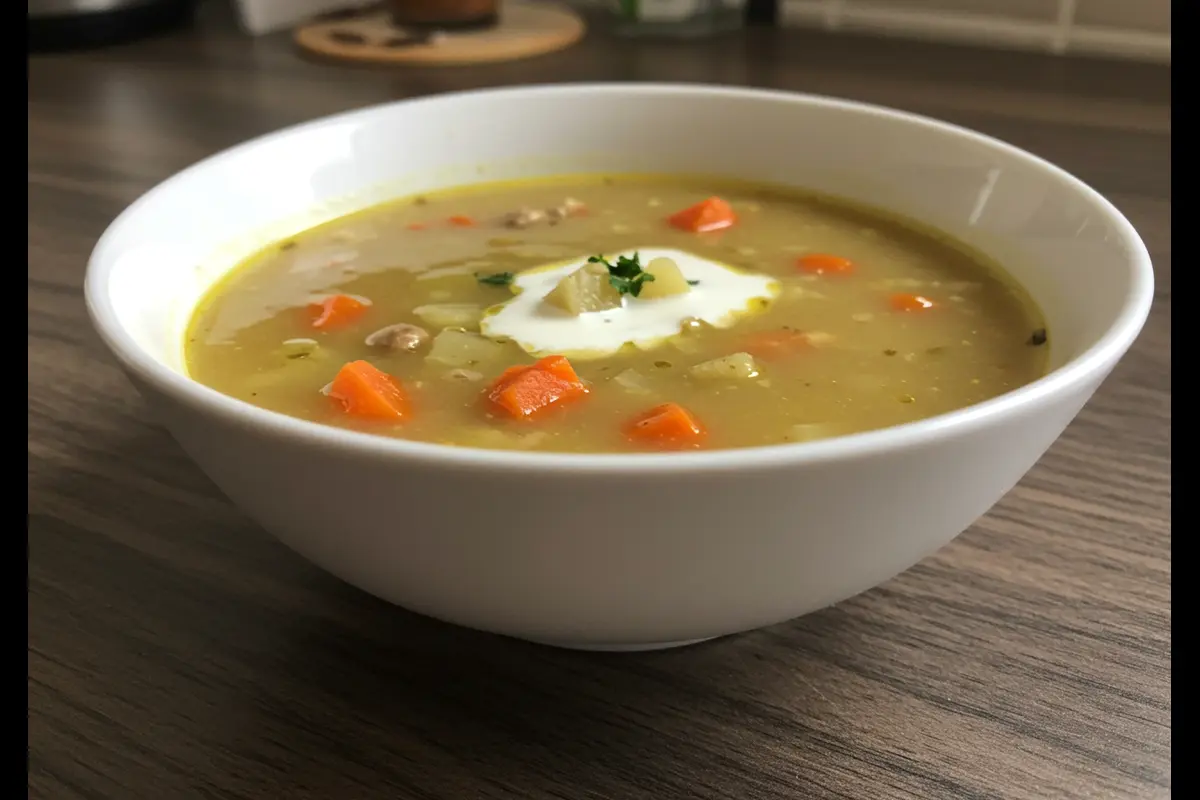Which big soups are gluten-free? This article explores a variety of delicious soup options that cater to a gluten-free diet. Learn about which big soups you can safely enjoy.
Understanding Which Big Soups Are Gluten-Free
Many people wonder which big soups are gluten-free. It’s a valid concern, especially for those with dietary restrictions. Gluten is a protein found in wheat, barley, and rye. Therefore, avoiding it can be challenging. However, many soup varieties are naturally gluten-free. This article guides you to enjoy big soups without gluten worries. Consequently, we will explore various types and ingredients.
The Basics of Gluten-Free Diets and Soups
Following a gluten-free diet means avoiding all sources of gluten. This is vital for people with celiac disease or gluten sensitivity. Many commercial soups, however, include gluten-containing thickeners or flavorings. Therefore, it’s important to read labels carefully. Luckily, many delicious big soups are easy to make.
Why Some Soups Contain Gluten
Gluten is a common thickener in processed foods. Many soups use wheat flour or modified food starch containing gluten. Additionally, soy sauce, which may include wheat, is another sneaky culprit. Thus, vigilance is needed when choosing your soup.
Which Big Soups Are Gluten-Free: Popular Choices

Now, let’s explore some specific big soups that are generally safe for those avoiding gluten. These choices can be both satisfying and comforting.
Hearty Vegetable Soups
Many vegetable-based big soups are gluten-free. For example, a minestrone made with rice instead of pasta is often safe. Likewise, a lentil soup using gluten-free broth and seasonings also fits the bill. Furthermore, check the labels to make sure everything is gluten-free.
Tips for Making Gluten-Free Vegetable Soups
To make sure your vegetable soup is gluten-free, begin with a gluten-free broth. Avoid bouillon cubes or paste that might include gluten. Then, thicken with mashed potatoes, pureed vegetables, or a cornstarch slurry. Also, use only gluten-free spices and seasonings.
Creamy Tomato Soups
Some creamy tomato soups are safe. However, traditional versions often use wheat flour as a thickener. Therefore, you must choose carefully. Look for recipes that use cornstarch or pureed potatoes for creaminess instead. Specifically, avoid canned cream of tomato unless it’s marked gluten-free. In addition, homemade versions are often a safe bet.
Gluten-Free Thickening Methods
Instead of wheat flour, use pureed vegetables, cornstarch, or tapioca starch to thicken soup. Additionally, a little bit of potato also does the trick. Moreover, these options will keep your soup gluten-free. Ultimately, they will maintain the creamy texture you want.
Chicken and Rice Soups
A classic chicken and rice soup can often be gluten-free. However, you should ensure the broth is gluten-free. Likewise, check the rice type, as some seasoned rice mixes contain gluten. Plain white or brown rice is usually fine. Equally, make sure the chicken is not pre-seasoned with gluten-containing products.
Preparing Gluten-Free Chicken Broth
Using a gluten-free broth is essential when preparing chicken soup. Make your own with fresh chicken, herbs, and water. Conversely, check labels carefully when buying prepared broths. Ultimately, gluten-free broths are a safe alternative.
Which Big Soups Are Gluten-Free: Regional and International Flavors
Let’s discover some globally inspired big soups and see if they fit the gluten-free profile. Chiefly, these recipes are full of flavor and are mostly safe.
Thai Coconut Soups
Many Thai coconut soups like Tom Kha are naturally gluten-free. they often rely on coconut milk, lemongrass, and galangal. However, you must always ensure that the sauces or curry pastes are gluten-free. Therefore, reading the label is crucial.
Ingredients to Watch in Asian Soups
Specifically, avoid soy sauce unless it’s certified gluten-free. Additionally, some fish sauces might include gluten additives. Accordingly, always double-check the ingredients to ensure no surprises.
Mexican-Inspired Soups
Mexican soups like tortilla soup can be easily adapted for a gluten-free diet. However, traditional tortilla strips are made from wheat. Therefore, use baked corn tortilla chips as an alternative. Also, ensure that the broth and seasonings are gluten-free.
Choosing Gluten-Free Toppings
When choosing toppings, avoid wheat-based croutons or tortillas. Instead, use avocado, fresh herbs, or gluten-free tortilla chips. Furthermore, this adds flavor without any gluten.
Other Global Gluten-Free Soup Options
For example, many South American stews or African-inspired soups are naturally gluten-free. These soups use gluten-free grains, legumes, and spices. Always, verify the specific ingredients to ensure the recipe is gluten-free. Moreover, exploring regional soups increases your culinary options.
Which Big Soups Are Gluten-Free: What to Avoid
Now, let’s discuss what to avoid when selecting big soups. Recognizing gluten triggers helps ensure you stay healthy and safe.
Cream-Based Soups and Thickeners
Many cream-based soups use wheat flour. Also, some brands use modified food starch that might contain gluten. Therefore, always check the ingredient list. Specifically, avoid any soup that doesn’t specify its status.
Processed Soups and Hidden Gluten
Processed soups often contain hidden sources of gluten. For instance, hydrolyzed vegetable protein, modified food starch, and some flavorings can be problematic. Hence, checking labels is essential.
Soup Starters and Bouillon
Soup starters and bouillon cubes are often a source of hidden gluten. Thus, always choose gluten-free brands. Moreover, many organic options are easily found.
Which Big Soups Are Gluten-Free: Reading Labels
Reading labels carefully is the key to choosing gluten-free soups. Let’s explore the best practices for label checking.
Identifying Gluten-Free Labels
Look for labels that clearly state “gluten-free”. This means that the product meets the required standards for gluten-free certification. Undoubtedly, this is a reliable way to find safe choices.
Understanding Ingredient Lists
Understanding ingredient lists helps to identify hidden gluten. Check for wheat, barley, rye, and malt. Also, watch out for modified food starch, soy sauce, and hydrolyzed vegetable protein. Moreover, familiarizing yourself with these helps you make the best choices.
Cross-Contamination Concerns
Be mindful of cross-contamination. Some soups may be made in facilities that also process gluten-containing ingredients. Hence, look for products that are labeled as made in a dedicated gluten-free facility if you are highly sensitive.
Making Your Own

Making your own big soups is a great way to ensure they’re gluten-free. In addition, homemade soups are more customizable and delicious.
Building a Gluten-Free Soup Base
Firstly, choose a gluten-free broth. Then, select fresh gluten-free vegetables and proteins. Next, add seasonings, and herbs that are gluten-free. This will give you a flavorful and safe foundation.
Adding Flavor Naturally
Using fresh herbs, spices, and garlic enhances flavors without gluten. For instance, ginger, turmeric, and cumin can make your soup more interesting. Additionally, natural ingredients ensure the best flavor.
Gluten-Free Thickening Methods
As previously mentioned, use cornstarch, tapioca starch, or pureed vegetables to thicken your soup. Furthermore, these methods will not introduce gluten.
Which Big Soups Are Gluten-Free?
Enjoying delicious big ones is possible with the right knowledge and care. Consequently, you can confidently select or create gluten-free options.
Exploring a Variety of Gluten-Free Options
By being informed, you can safely explore a wide range of soups. Therefore, both home-cooked and store-bought can be part of a varied and gluten-free diet.
Always Double-Check
Always check labels, even for products you regularly use. Because ingredients and manufacturing processes can change. Ultimately, this helps you avoid unexpected gluten exposure.
The Joy of Gluten-Free Soup
Finally, remember that enjoying gluten-free soups can be delightful. With the right knowledge, everyone can find a bowl of goodness. Thus, you can enjoy comforting big soups that align with your needs.
Frequently Asked Questions (FAQs)
What kinds of soup are gluten-free?
Many types of soup can be gluten-free. Vegetable soups, chicken and rice soup, and some coconut-based soups are often safe. Always verify the ingredients and look for certified gluten-free labels.
What cans of soup are gluten-free?
Several brands offer gluten-free canned soups. Look for specific gluten-free labels. Check the ingredient list to avoid hidden sources of gluten. Some brands include Amy’s, Pacific Foods, and Progresso’s gluten-free varieties.
Are any Heinz soups gluten-free in the UK?
Heinz has a range of gluten-free soups available in the UK. Always check the label for the gluten-free claim because recipes can vary. Look for clear labeling and carefully review the ingredient list.
Why is chicken broth not gluten-free?
Some chicken broths include gluten as a thickening agent or as part of flavor enhancers. Therefore, always select broths that are labeled as gluten-free. Cross-contamination can occur, so always be vigilant in your selections.

